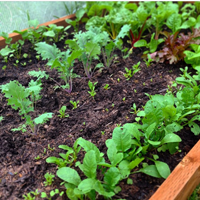Don’t Worry About Leafcutter Bees!
Leaf cutters always cut extremely neat semi-circles and ovals, unlike caterpillars which leave irregular holes in leaves. They prefer soft tissue plants such as roses, plumbago, hibiscus and crape myrtles. There is no chemical control since they do not eat the leaves they cut. Nesting season is very short, so after a week or two, they go away… thank goodness!
Feed Your Veggies
Vegetables are heavy feeders. Use Espoma Plant Tone once a month to keep your vegetables producing through the season.
Watch Out For Cabbage Loopers
It’s time for tiny green looper worms to be eating the leaves of your broccoli, cabbage and cauliflower. Use
Hi-Yield Thuricude or Fertilome Dipel Dust to control these pesky worms. It is completely organic and safe up to the day of harvest. Just rinse and eat!
New For Your Garden: Watercolor Rose
It’s a color extravaganza! The flowers may be simple in style, but they’re captivating to watch as they change colors completely with each day. Hues of yellow, pink, cerise & ruby are carried atop loads of clean deep green leaves on a very bushy full plant. Dark red new shoots add to the show. This beauty is delicate to look at and tough as nails when it comes to garden performance. Complimented with a moderate apple fragrance; we think you’ll enjoy this one in your rose garden!


 Now’s the time to prepare the soil with fresh compost and plan your garden layout. Sow seeds of root crops, ex. beets, carrots, radish and turnips. Don’t forget your leafy vegetables such as chard, collards, kale, lettuce, mustard and spinach. Transplants of broccoli, cabbage and cauliflower can also be planted now. If you are limited on space, you may want to take this time to let the garden rest. In just a few weeks it will be time to think about tomatoes, beans, corn, cucumbers, squash and more of the warm season veggies. We will begin bringing in tomatoes the middle of the month, but suggest you transplant them into 1 gal pots so you can take them in on the cold nights. If you prefer to wait till after fear of frost, we will have 1 gallon plants already established for you to plant at a later date. The longer you wait, the bigger you need to buy.
Now’s the time to prepare the soil with fresh compost and plan your garden layout. Sow seeds of root crops, ex. beets, carrots, radish and turnips. Don’t forget your leafy vegetables such as chard, collards, kale, lettuce, mustard and spinach. Transplants of broccoli, cabbage and cauliflower can also be planted now. If you are limited on space, you may want to take this time to let the garden rest. In just a few weeks it will be time to think about tomatoes, beans, corn, cucumbers, squash and more of the warm season veggies. We will begin bringing in tomatoes the middle of the month, but suggest you transplant them into 1 gal pots so you can take them in on the cold nights. If you prefer to wait till after fear of frost, we will have 1 gallon plants already established for you to plant at a later date. The longer you wait, the bigger you need to buy. Planning For Spring Flowers
Planning For Spring Flowers 
 Companion Plants For Your Veggie Garden
Companion Plants For Your Veggie Garden


 easier, and can save you a lot of sweat.
easier, and can save you a lot of sweat.  spin this web for protection. Usually the web will disintegrate in two or three days and will disappear almost a suddenly as it appeared. Leave them alone and let them do their job of cleaning up your trees or shrubs. Thank goodness for good bugs!
spin this web for protection. Usually the web will disintegrate in two or three days and will disappear almost a suddenly as it appeared. Leave them alone and let them do their job of cleaning up your trees or shrubs. Thank goodness for good bugs!  -Debbie
-Debbie





